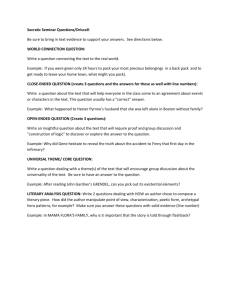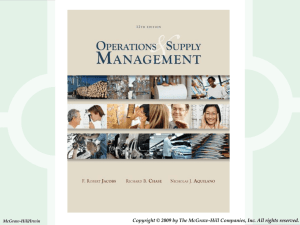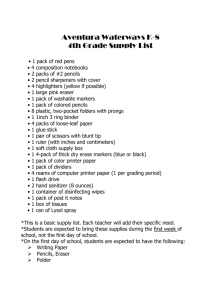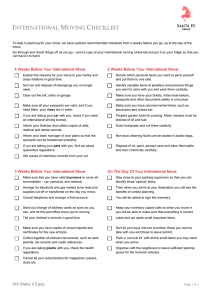chp. 14
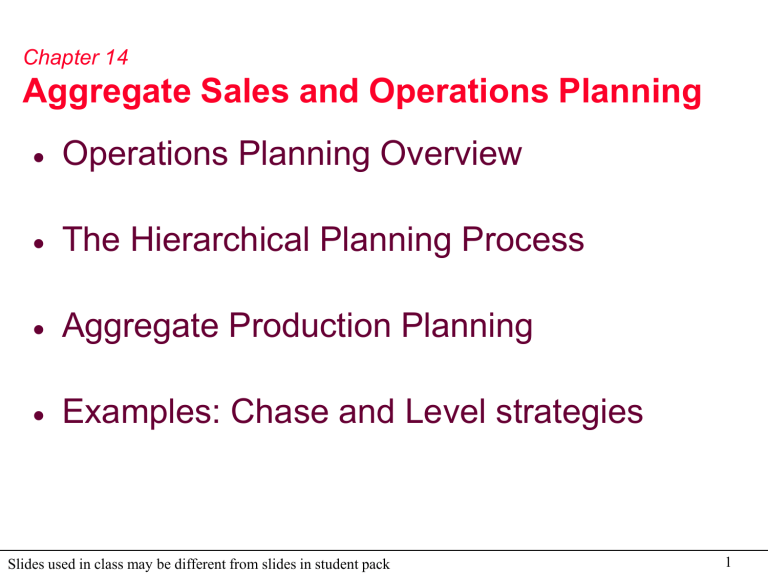
Chapter 14
Aggregate Sales and Operations Planning
Operations Planning Overview
The Hierarchical Planning Process
Aggregate Production Planning
Examples: Chase and Level strategies
Slides used in class may be different from slides in student pack 1
Operations Planning Overview
Long-range planning
–
–
Greater than one year planning horizon
Usually with yearly increments
Intermediate-range planning
– Six to eighteen months
– Usually with monthly or quarterly increments
Short-range planning
– One day to less than six months
– Usually with weekly increments
Slides used in class may be different from slides in student pack 2
Process Planning
Longrange
Forecasting and Demand
Mgmt.
Intermediaterange Manufacturing
Strategic Capacity Planning
Sales and Operations (Aggregate) Planning
Sales Plan Aggregate Operations Plan
Services
Master Production Scheduling
Material Requirements Planning
Shortrange
Order Scheduling
Slides used in class may be different from slides in student pack
Weekly Workforce &
Customer Scheduling
Daily Workforce &
Customer Scheduling
3
Hierarchical Production Planning
Decision Level Decision Process Forecasts needed
Corporate
Allocates production among plants
Annual demand by item and by region
Plant manager
Determines seasonal plan by product type
Shop superintendent
Determines monthly item production schedules
Slides used in class may be different from slides in student pack
Monthly demand for 15 months by product type
Monthly demand for 5 months by item
4
Aggregate Planning
Goal: Specify the optimal combination of
–
–
–
Product group or broad category - family
(Aggregation)
Intermediate-range planning period: 6-18 months
Slides used in class may be different from slides in student pack 5
Balancing Aggregate Demand and Aggregate Production Capacity
10000
Suppose the figure to the right represents forecast demand in units.
Now suppose this lower figure represents the aggregate capacity of the company to meet demand.
10000
8000
6000
4000
2000
0
4500
Jan
5500
Feb
7000
Mar Apr
8000
May
6000
Jun
9000
What we want to do is balance out the production rate, workforce levels, and inventory to make these figures match up.
10000
8000
6000
4000
2000
0
4500
Jan
4000
Feb Mar
8000
Apr
4000
May
6000
Jun
Slides used in class may be different from slides in student pack 6
Aggregate Scheduling Goals
–
–
–
–
13-13
Slides used in class may be different from slides in student pack 7
Required Inputs to the Production
Planning System
Competitors’ behavior
Raw material availability
Market demand
External to firm
External capacity
Planning for production
Economic conditions
Current physical capacity
Current workforce
Inventory levels
Activities required for production
Slides used in class may be different from slides in student pack
Internal to firm
8
Key Strategies for Meeting Demand
Chase - Match production to customer order rate by hiring and laying off employees
Level - Stable workforce with constant output, inventory and backlogs absorb fluctuations in demand
Some combination of the two - Stable workforce, variable hours - vary output through overtime or flexible schedules
9 Slides used in class may be different from slides in student pack
Costs Relevant to Aggregate Planning
Direct and indirect labor costs and overtime
Costs associated with changing the production rate - hiring, training, layoffs, temps
Inventory holding costs - costs of capital, storage, insurance, taxes, spoilage, obsolescence
Backordering costs - expediting, loss of goodwill, lost sales due to stocking out
Slides used in class may be different from slides in student pack 10
Aggregate Planning Examples: Unit
Demand and Cost Data
Suppose we have the following unit demand and cost information:
Demand/mo Jan Feb Mar Apr May Jun
4500 7500 10500 11000 8000 5000
Materials
Holding costs
$5/unit
$1/unit per mo. based on ending inv.
Marginal cost of backorder $1.25/unit per mo.
Hiring and training cost $200/worker
Layoff costs
Labor hours required
Straight time labor cost
Beginning inventory
$250/worker
.15 hrs/unit
$8/hour
250 units
Productive hours/worker/day 7.25
Paid straight hrs/day 8
Slides used in class may be different from slides in student pack 11
Cut-and-Try Example: Determining
Straight Labor Costs and Output
Given the demand and cost information below, what are the aggregate hours/worker/month, units/worker, and dollars/worker?
Demand/mo Jan Feb Mar Apr May Jun
4500 7500 10500 11000 8000 5000
Productive hours/worker/day 7.25
Paid straight hrs/day 8
Days/mo
Productive Hrs/worker/mo
Units/worker/month
$/worker
Jan Feb Mar
20
145
20
145
20
145
966.7
966.7
966.7
$1,280 $1,280 $1,280
Apr
20
145
966.7
$1,280
May Jun
20
145
20
145
966.7
966.7
$1,280 $1,280
12 Slides used in class may be different from slides in student pack
Chase Strategy
(Hiring & Firing to meet demand/ No Shortage)
Lets assume our current workforce is 7 workers.
Days/mo
Productive Hrs/worker/mo
Units/worker/month
$/worker
Jan
20
145
966.7
$1,280
Demand
Beg. inv.
Net req.
Req. workers
Beg. Workers
Hired
Fired
Workforce
Production
Jan
4500
250
4250
5
7
0
2
5
4834
Ending inventory 584
Slides used in class may be different from slides in student pack 13
Below are the complete calculations for the remaining months in the six month planning horizon.
Days/Month
Productive Hrs./Worker/Month
Units/Worker/Month
$/Worker
Demand
Beg. inv.
Net req.
Req. workers
Beg. Workers
Hired
Fired
Workforce
Production
Ending inventory
Jan Feb Mar Apr May Jun
20
145
20
145
20
145
20
145
20
145
20
145
966.7
966.7
966.7
966.7
966.7
966.7
$1,280 $1,280 $1,280 $1,280 $1,280 $1,280
Jan Feb Mar Apr May Jun
4,500 7,500 10,500 11,000 8,000 5,000
250 584 818 952 586 320
4,250 6,916 9,682 10,048 7,414 4,680
5 8 11 11 8 5
7 5 8 11 11 8
0
2
3
0
3
0
0
0
0
3
0
3
5
4834
584
8 11 11
7734 10634 10634
818 952 586
8
7734
320
5
4834
154
Slides used in class may be different from slides in student pack 14
Below are the complete calculations for January with the other costs included.
Demand
Beg. inv.
Net req.
Req. workers
Beg. Workers
Hired
Fired
Workforce
Production
Ending inventory
Costs:
Material
Labor
Hiring cost
Firing cost
Holding Cost
Jan
4,500
250
4,250
5
7
5
4834
0
2
584
$24,170
$6,400
$0
$500
$584
Slides used in class may be different from slides in student pack 15
Below are the complete calculations for the remaining months in the six month planning horizon with the other costs included.
Hiring Cost
Firing Cost
Material Cost/unit
Holding Cost
$200
$250
$5
$1
Demand
Beg. inv.
Net req.
Req. workers
Beg. Workers
Hired
Fired
Workforce
Production
Ending inventory
Costs:
Material
Labor
Hiring cost
Firing cost
Holding Cost
Jan
4,500
250
4,250
5
7
0
2
5
4834
584
Feb Mar Apr
7,500 10,500 11,000
584
6,916
8
5
3
0
8 11 11
7734 10634 10634
818
818
9,682
11
8
3
0
952
952
10,048
11
11
0
0
586
May
8,000
586
7,414
8
11
0
3
8
7734
320
Jun
5,000
320
4,680
5
8
0
3
5
4834
154
$24,170 $38,670 $53,170 $53,170 $38,670 $24,170 $232,020
$6,400 $10,240 $14,080 $14,080 $10,240 $6,400 $61,440
$0 $600 $600 $0 $0 $0 $1,200
$500
$584
$0
$818
$0
$952
$0
$586
$750
$320
$750
$154
$2,000
$3,414
$300,074
Slides used in class may be different from slides in student pack 16
Level Workforce Strategy (Surplus and Shortage Allowed minimize ending inventory)
Lets take the same problem as before but this time use the Level
Workforce strategy.
What workforce level will minimize ending inventory?
Total demand =
Beginning inventory:
Total production required =
Minimum production required per month =
Workers required =
Actual monthly production =
Slides used in class may be different from slides in student pack 17
Below are the complete calculations for the six months in the planning horizon.
Demand
Beg. inv.
Net req.
Req. workers
Beg. Workers
Hired
Fired
Workforce
Production
Ending inventory
Costs:
Material
Labor
Hiring cost
Firing cost
Holding Cost
Backorder Cost
Jan
4,500
250
4,250
8
7
1
0
8
7734
3,484
Feb Mar Apr
7,500 10,500 11,000
3,484
4,016
8
0
8
7734
3,718
8
0
3,718
6,782
8
8
0
0
8
7734
952
10,048
8
8
0
0
8
7734
May
8,000
-2,314
10,314
8
8
0
0
8
7734
952 (2,314) (2,580)
Jun Total
5,000
-2,580
7,580
8
0
0
8
7734
154
8
46,500
$38,670 $38,670 $38,670 $38,670 $38,670 $38,670 $232,020
$10,240 $10,240 $10,240 $10,240 $10,240 $10,240 $61,440
$200 $0 $0 $0 $0 $0 $200
$0 $0 $0 $0 $0 $0 $0
$3,484 $3,718
$0 $0
$952 $0 $0
$0 $2,893 $3,225
$154
$0
$8,308
$6,118
$308,086
Slides used in class may be different from slides in student pack 18
50,000
45,000
40,000
35,000
30,000
25,000
20,000
15,000
10,000
5,000
0
Level Strategy to Minimize Ending Inventory with
No Backorders By End of June
Jan Feb Mar
Cumulative Demand
Apr May
Cumulative Production
Jun
Slides used in class may be different from slides in student pack 19
Master Scheduling Process - Determine amounts and dates of each end item to be produced
Inputs
Beginning inventory
Forecast
Customer orders
Master scheduling
Outputs
Projected inventory
Master production schedule
Uncommitted inventory
Slides used in class may be different from slides in student pack 20
Master Scheduling Drives:
Rough cut capacity planning verifies equipment and labor availability
Material requirements planning (MRP) breaks end product requirements into a materials plan for component parts
Slides used in class may be different from slides in student pack 21
